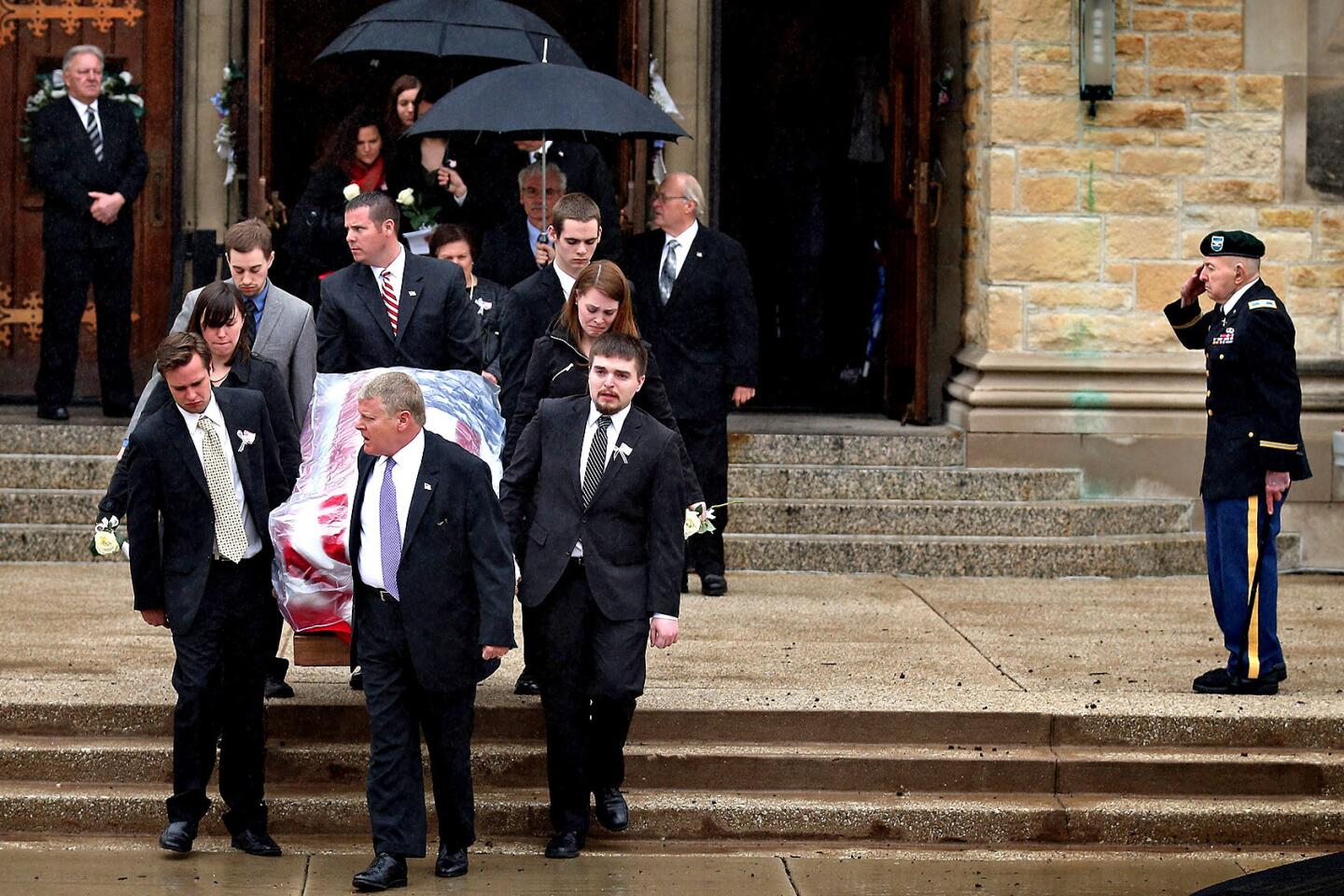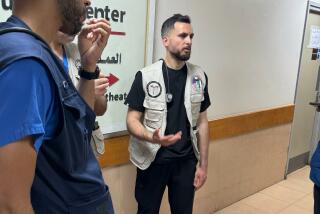Great Read: U.S. Embassy worker undaunted by Taliban attack, injuries
- Share via
Reporting from KABUL, Afghanistan — Lying in a ditch, his head throbbing from the bomb blast, Abbas Kamwand wiggled his toes. He was shocked to discover that he still could.
An Afghan soldier grabbed his hand and helped him up. Around him, vehicles lay mangled, and dark smoke climbed to the sky. He noticed the body of a young State Department colleague splayed facedown in the dirt.
Kamwand limped over and placed his hands under her belly to lift her up. He raised her a few inches before realizing that her bloodied left leg still lay on the ground, apparently severed in the blast. Soldiers shouted at him to take cover, that another bomb could strike.
The April 6, 2013, suicide car bombing in the southern town of Qalat left three U.S. soldiers, a Pentagon interpreter, an Afghan doctor and the 25-year-old diplomat, Anne Smedinghoff, dead.
Kamwand had joined the U.S. Embassy in Kabul just months earlier as its only native-born spokesman — the State Department’s Afghan face — after three decades in America. The 58-year-old was seriously wounded: an 8-inch gash on his left leg, a 5-inch wound on his right, with shrapnel piercing his eye, ear and the nerves along his forehead.
After emergency treatment, he was evacuated home to the Kansas City area, where he and his wife, Hosnia, have lived since fleeing the Soviet occupation of Afghanistan. He required seven surgeries and skin grafts to his leg, and doctors say he needs at least two more procedures to remove remaining shrapnel. Because of nerve damage, he has all but lost his sense of smell.
Yet seven months after the attack, Kamwand was back at his desk inside the fortress-like embassy compound in Kabul.
For a diplomatic corps still reeling from the loss of the only State Department officer to die in the Afghan war, his return in November was an emotional moment.
“My thought personally was that, yes, it’s a reality of life that you’ve been hard hit, you’ve fallen, but you’re not going to make that part of your life forever,” Kamwand said. “To me, coming back was a personal statement to the enemy that they tried, but they failed.”
::
The United States had been at war in Afghanistan for 11 years but never had a Dari-language spokesman in Kabul until Kamwand was hired in late 2012. With the Pentagon beginning to withdraw troops and hand over its bases to the Afghan government, the embassy was struggling to articulate America’s relationship with a country still mired in conflict.
Masha Hamilton, then the embassy’s director of public diplomacy, thought that appointing an Afghan American to make media appearances would be more effective than the usual practice of translating a spokesman’s words from English. Ambassador James B. Cunningham lobbied the State Department to get the position approved.
Hamilton interviewed several candidates but found that few were willing to appear on television. Still others didn’t want to use their real names.
Then she met Kamwand, bald and bespectacled, with a bushy mustache, who was working as a communications analyst for a military contractor in Kabul.
“He showed courage that not everybody had, because not everybody wanted to be publicly associated with the U.S. Embassy and the Americans,” said Hamilton, who is now vice president for communications at Concern Worldwide, a humanitarian organization.
Kamwand had left Afghanistan in 1980 when Kabul was roiled by protests against the Soviet invasion. As a refugee in Pakistan, he launched a resistance periodical, the Voice of Freedom, published on a hand-crank copier with whatever cash he and friends could scrounge together, and wrote letters nearly every week to a pretty medical student he had met back home named Hosnia.
Hosnia had been jailed by the Soviets for seven months for participating in demonstrations and was already living in the United States, where she had gained asylum. She traveled to Pakistan to marry Kamwand, and together they settled in a suburb of Kansas City, where she worked in a medical lab and he drove a taxi. They had two children, a boy and a girl.
Kamwand became a U.S. citizen in 2003, earned a business degree from Emporia State University and in 2009 was hired by the contractor in Kabul. He had not been back to Afghanistan since the Taliban took power in 1996, and he found the country bore little resemblance to his memories.
Growing up, he had often traveled to Bamian province, northwest of Kabul, to picnic near famed sandstone statues of Buddha; the Taliban destroyed them in 2001. By 2009, the capital itself was a gray maze of blast walls and worsening poverty, dominated by coalition armored vehicles.
He saw an opportunity to help his homeland emerge from conflict. But for Hosnia, who hasn’t returned to Afghanistan in three decades, the separation was difficult.
She had lost dozens of relatives during the Soviet occupation, including her brother, who disappeared into military custody and was never found. Although her husband called daily from Kabul, Hosnia was left alone with their then-teenage children, who sometimes struggled with their father’s move.
“He’s trying to do good, to do something that helps his country,” she said. “It gives him that fulfillment. But the kids may not understand that. They have never been there. We told them some stories about our life, but they’re still kind of young to understand it.”
Then came the bombing in Qalat.
::
The Kamwand residence, on a meandering tree-lined street in Lenexa, Kan., is an attractive two-story tract home with a small garden in front. During his recovery, however, Kamwand says, it sometimes seemed like a prison.
His left leg wound had to be cleaned twice daily, the muscles regularly massaged and rubbed with lotion. There were countless stretches and exercises. As his strength returned, he could take walks with Hosnia around their neighborhood.
But when she went to work, he sat home alone, listless and impatient, plotting a way to return to Kabul.
“I would come home and be like, ‘Did you eat anything since breakfast?’ ‘Did you do this, did you do that?’ It was always no,” she recalled. “It felt like he was not himself. I could see he was depressed.”
Sometimes Kamwand would snap at the kids. Weaning himself off prescription painkillers resulted in weeks of arduous withdrawal symptoms.
At his wife’s insistence, he began seeing a psychiatrist, the two of them sometimes attending sessions together. He traveled to Washington to meet State Department doctors, who warned that if he went back to the embassy he would confront the periodic sirens that indicate a nearby bomb attack.
They thought Kamwand might suffer flashbacks to Qalat, where he and the others had traveled to showcase books donated by the U.S. government. The attack raised questions about whether officials had taken adequate security precautions for a mission that was little more than a photo opportunity.
Yet Kamwand was undaunted. “My statement, in not so many words, was that if the Taliban couldn’t kill me, you can’t kill me,” he said.
At that point, Hosnia realized that her husband needed to return to his homeland.
“He was forced to leave Afghanistan; it wasn’t his choice,” she said. “That’s when I decided that if he doesn’t go back, it’s going to be really hard for him. If he can feel like he can do the job he did before and face that fear, it would help him get over the trauma. And then I hope he comes home, and it will be his decision.”
The State Department finally granted Kamwand medical clearance. When he told their children, he remembers, he was met with tears from his daughter, Awista, a recent university graduate, and a stern silence from his son, Arash, an incoming college freshman.
Kamwand hasn’t decided how long he will remain in Kabul. He knows his family wants him home. But U.S. officials who served with him said he has already made the toughest decision of his career.
“Abbas,” Hamilton said, “is absolutely a hero for coming back.”
More to Read
Sign up for Essential California
The most important California stories and recommendations in your inbox every morning.
You may occasionally receive promotional content from the Los Angeles Times.












